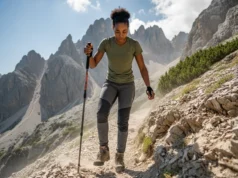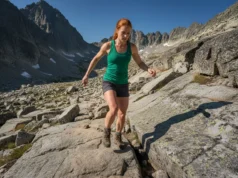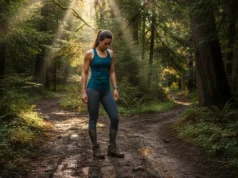In this article
The most common medical complaint on the trail isn’t a sprained ankle or a twisted knee; it’s the humble blister—reported three times more often than back pain and capable of derailing everything from a quick gravel-path ramble to a multi-day backcountry adventure. Yet that blister isn’t caused by simple rubbing or a superficial friction burn; it is the result of an invisible biomechanical force called shear—an intraepidermal tear within the stratum spinosum of your skin, triggered when the bones of your foot slide inside the boot while the outer skin surface is locked in place by high-friction socks. This guide delivers a scientifically-backed, biomechanically-aware, and trail-scenario-tested protocol that systematically eliminates shear, transforming your new synthetic hiking boots, leather hiking boots, or full-grain leather hiking boots into a zero-blister extension of your body. By the end, you will have mastered the clinical-level protocol for selecting the right fit before purchase—accounting for afternoon foot swell, Merino wool socks, synthetic socks, sock liners, and aftermarket insoles—understood why full-grain leather requires 50-plus miles while synthetics feel comfortable after 1–3 hikes, executed a four-phase conditioning plan that scales from indoor use to sidewalks, gravel paths, light trails, and weighted pack training, and learned advanced lacing techniques like the Heel Lock and Surgeon’s Knot to customize fit for high arches, wide toe boxes, or stubborn heel lift.
Why Is a Proper Break-In a Medical Imperative?
Before you tighten a single lace, understand the enemy. A friction blister is not surface abrasion; it is a shear-induced tear that occurs when the foot’s bone structure moves inside the boot while the skin is held stationary by moisture-amplified friction against your sock. Sweat increases the coefficient of friction, “locking” skin to fabric and magnifying the shear deformation that rips the stratum spinosum from within. The body responds by filling the void with plasma-like fluid, creating the classic blister sac. A successful gradual process—one that conforms the boot’s footbed, flexes the midsole, and conditions your arches—reduces pressure points and slippage, thereby minimizing the shear forces that initiate the tear. Studies record blister incidence rates as high as 95 % during multi-day events, confirming that this is the most common medical issue on trail. For the definitive medical explanation, consult this foundational paper on the pathophysiology of friction blisters, then explore a complete system for stopping blisters in their tracks to translate science into practice.
Moisture management is non-negotiable: cotton socks absorb sweat and spike friction, whereas moisture-wicking Merino wool socks or synthetic socks paired with a thin synthetic sock liner transfer the friction point from skin-sock to sock-sock. Aftermarket insoles tailored to your arch type distribute pressure evenly, reducing sore arches and preventing the cascade of misalignment that leads to hotspots. Remember, signs of discomfort—persistent heel lift, pinched toes, or pressure zones—indicate boots are not broken in and may never be if the initial proper fit is lacking.
How Do I Master the Fit Before Leaving the Store?
What is the In-Store Protocol for a Perfect Fit?
Time your purchase for the afternoon, when feet are at maximum swell, and arrive equipped with the exact Merino wool socks, sock liners, and aftermarket insoles you will use on trail. Slide your foot forward until the toes touch the front; you should have one finger’s width of space behind the heel to prevent toe-impact on descents. Lace firmly and use any available incline ramp to verify heel lock—minimal to no heel lift means you have avoided the primary cause of heel blisters. Walk the carpeted floor for at least fifteen minutes; any minor irritation you detect now will be magnified into a debilitating pain point once you add increased distance and varied terrain.
Next, assess width and volume: the heel and instep should feel snug, yet the toe box must provide ample toe wiggle room to avoid numbness. This micro-hike inside the store is your final filter; if the boots feel perfect now, the step-by-step break-in process can optimize the fit, but if you sense pressure zones or ankle support gaps, no amount of conditioning will fix a fundamentally bad last. For authoritative university guidance, see an educational guide on outdoor activities, and for deeper boot anatomy, visit decoding the full anatomy of a hiking boot.
What Gear is Essential for a Zero-Blister System?
How Do Boot Materials Dictate the Break-In Process?
Full-grain leather hiking boots are the gold standard for durability and water resistance, but their dense fiber structure demands patience—expect 2–3+ weeks and 50-plus miles of gradual process before the leather molds to your foot like bespoke armor. Nubuck and suede leather soften faster, offering a 1–2-week window and moderate flexibility, yet they sacrifice some longevity and weatherproofing. Synthetic hiking boots and hiking shoes skip the marathon break-in entirely; their lightweight, breathable nylon or polyester uppers feel comfortable after 1–3 hikes, making them ideal for quick gravel-path outings or humid climates.
The trade-off is clear: synthetics trade durability and odor-resistance for speed of comfort, while full-grain leather trades time for a lifetime of rugged service. For synthetics, “break-in” is less about molding stiff material and more about confirming fit and spotting manufacturing flaws. A material comparison matrix—covering break-in time estimate, durability, water resistance, breathability, weight, and best for use case—will be provided to guide your choice. For a deep dive into leather, see a complete guide to men’s leather hiking boots.
Hiking Boot Material Comparison
A detailed look at the performance of different boot materials based on key characteristics.
Performance Ratings
Durability: Very High
Water Resistance: Very High
Breathability: Low
Break-in Time: 4-8 weeks (50+ miles)
Best For
Heavy-duty backpacking, off-trail travel, mountaineering; ideal for users prioritizing longevity and durability above all else.
Performance Ratings
Durability: High
Water Resistance: High
Breathability: Medium
Break-in Time: 1-3 weeks (20-30 miles)
Best For
Day hiking to multi-day backpacking; for users wanting a balance of durability and comfort without the extensive break-in period of full-grain leather.
Performance Ratings
Durability: Medium
Water Resistance: Very High
Breathability: Low-Medium
Break-in Time: 1-5 hikes (<20 miles)
Best For
Day hiking and light backpacking in wet or varied conditions. Excellent for users prioritizing out-of-the-box comfort and waterproof performance.
Performance Ratings
Durability: Medium-Low
Water Resistance: Low
Breathability: Very High
Break-in Time: 0-2 hikes (<10 miles)
Best For
Hot weather hiking, desert conditions, and trail running. Best for users prioritizing maximum breathability, low weight, and instant comfort.
Why Are Socks and Insoles Considered Essential Gear?
Cotton socks are a liability; they absorb sweat, hold moisture against the skin, and spike the coefficient of friction that triggers hotspots and blisters. Replace them immediately with moisture-wicking Merino wool socks or synthetic socks engineered to pull perspiration away from the skin and maintain a lower friction interface. Layering a thin synthetic sock liner beneath a thicker hiking sock shifts friction from skin-sock to sock-sock, an advanced tactic proven in this controlled study on sock type and foot lesions.
Pro-Tip: Bring your chosen socks and insoles to the store and test them inside every candidate boot; the combined volume is the only volume that matters.
Stock insoles are generic slabs that offer minimal arch support; swapping them for aftermarket insoles matched to your arch height—high, neutral, or low—distributes pressure evenly, reduces sore arches, and aligns the kinetic chain. The synergy between boots, socks, insoles, and lacing techniques determines whether your day hike ends in triumph or in moleskin triage. For a dedicated sock deep-dive, see our ultimate guide to hiking socks.
What is the Step-by-Step Protocol for Breaking In Boots?
How Should I Progress Through the Four Phases of Conditioning?
Phase 1: Indoor Acclimatization (1 week). Wear the full boot system—boots, Merino wool socks, sock liners, and aftermarket insoles—indoors for 1–2 hours daily. This initiates footbed molding and reveals any pressure zones without risking varied terrain. Use stairs to test heel lock and ensure no heel lift.
Phase 2: Pavement & Light Paths (1 week). Graduate to 30–60 minute walks on sidewalks or smooth gravel paths. These short walks flex the midsole and create natural crease patterns in a controlled manner, building flexibility while keeping load light.
Phase 3: Trail Simulation (1 week). Take 1–2 hour hikes on light trails with moderate elevation and mixed surfaces. This exposes the boot to three-dimensional forces—ascents, descents, lateral torque—surfacing any remaining hotspots before committing to longer mileage.
Pro-Tip: Keep a mileage log during Phase 4; boots rarely lie, and sudden pain after a mileage spike is your cue to back off and re-evaluate fit or technique.
Phase 4: Progressive Load Integration (1–2 weeks). Begin day hikes of increasing distance while adding a light backpack starting at 10 lbs and ramping to your anticipated trail weight. This final phase conditions both the boot’s durability and your foot’s soft tissue for backcountry adventure. The principle of progressive overload—validated in Physical Activity Guidelines for Americans—underpins every incremental step. For foundational safety tips, see essential tips for beginner hikers.
How Can I Customize the Fit for My Unique Feet?
What Lacing Techniques Solve Specific Foot Problems?
Heel slippage sabotages downhill strides and breeds heel blisters. Counter it with the Heel Lock or Surgeon’s Knot: cinch an extra overhand loop over the instep to anchor the heel cup and eliminate vertical movement. If you feel pressure on the top of the foot due to a high instep, switch to Window Lacing—skip a crossover to create a pressure-free window over sensitive tendons while retaining overall tension.
Wide forefoot hikers can deploy Toe-Relief Lacing, skipping the lowest eyelets to open the toe box and allow natural toe wiggle room. Overpronation or flat feet benefit from Supportive Lacing: add extra tension on the medial side to create a biomechanical wall that limits inward roll and reduces sore arches. A lacing troubleshooting table—complete with step-by-step diagrams—will be provided. For the medical rationale, see Assessments and Treatment Options for Musculoskeletal Conditions.
What Are the Final Checks, Forbidden Hacks, and On-Trail First Aid?
What Dangerous “Hacks” Should I Avoid?
Internet folklore promises overnight comfort but risks catastrophic failure. Soaking boots in water softens leather temporarily, but as the material dries it loses essential oils, becoming brittle and prone to cracking. Extreme heat—from a hair dryer, oven, or campfire—dries out leather, melts adhesives, and can cause sole delamination far from the trailhead.
Instead, treat full-grain leather with a quality leather conditioner to soften fibers gradually while preserving durability; for synthetics, focus solely on the phased walking protocol, as chemical treatments are ineffective and may damage the fibers. For suede or nubuck, avoid waxes or oils that flatten the nap and reduce breathability. If a hotspot flares on trail, stop immediately, dry the area, and apply moleskin or blister tape; then review building your own hiker’s first-aid kit for complete preparedness.
Conclusion
True blister prevention starts with understanding shear deformation—an internal skin tear, not surface rubbing. The foundation is a proper fit selected in the afternoon with your exact Merino wool socks, sock liners, and aftermarket insoles. A gradual process—indoor use, short walks, day hikes, and weighted pack training—safely conditions both boot durability and foot tissue. Advanced lacing techniques act as biomechanical tools to fine-tune heel lift, toe room, and arch support for your unique anatomy. You now hold the definitive blueprint for a zero-blister fit; put it into practice and share your success stories below to help fellow hikers master their most critical gear.
Frequently Asked Questions
How long does it take to break in hiking boots?
Break-in time is dictated by material properties: synthetic hiking boots and hiking shoes may feel dialed after 1–3 hikes totaling fewer than 20 miles, while full-grain leather hiking boots can demand 2–3+ weeks and 50-plus miles under a gradual process.
How do I know when my hiking boots are fully broken in?
Your boots are ready when they disappear from conscious awareness—no stiffness, heel lift, or hotspots. You should complete a day hike with a fully weighted pack without developing blisters, and the sole should flex smoothly with every stride.
What should I do if I feel a hotspot on the trail?
Stop immediately—delay converts a hotspot into a blister. Remove the boot and sock, dry the skin, and apply moleskin or blister tape directly over the irritation to eliminate friction.
What if my boots still hurt after trying everything?
Persistent pain after completing the step-by-step protocol and experimenting with lacing techniques indicates an incorrect proper fit or last shape. The break-in process can only optimize a good fit; it cannot fix a bad one. Discontinue use to prevent injury and seek professional refitting.
Risk Disclaimer: Hiking, trekking, backpacking, and all related outdoor activities involve inherent risks which may result in serious injury, illness, or death. The information provided on The Hiking Tribe is for educational and informational purposes only. While we strive for accuracy, information on trails, gear, techniques, and safety is not a substitute for your own best judgment and thorough preparation. Trail conditions, weather, and other environmental factors change rapidly and may differ from what is described on this site. Always check with official sources like park services for the most current alerts and conditions. Never undertake a hike beyond your abilities and always be prepared for the unexpected. By using this website, you agree that you are solely responsible for your own safety. Any reliance you place on our content is strictly at your own risk, and you assume all liability for your actions and decisions in the outdoors. The Hiking Tribe and its authors will not be held liable for any injury, damage, or loss sustained in connection with the use of the information herein.
Affiliate Disclosure: We are a participant in the Amazon Services LLC Associates Program, an affiliate advertising program designed to provide a means for us to earn advertising fees by advertising and linking to Amazon.com. As an Amazon Associate, we earn from qualifying purchases. We also participate in other affiliate programs and may receive a commission on products purchased through our links, at no extra cost to you. Additional terms are found in the terms of service.





